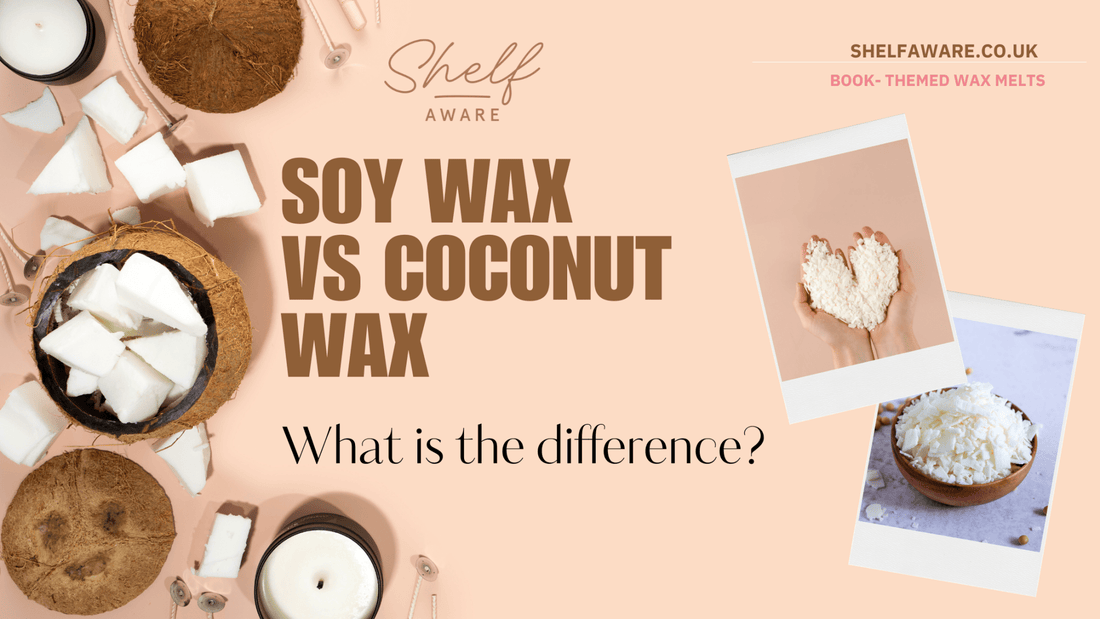When it comes to choosing the right wax for your wax melts, two popular options are soy wax and coconut wax. Both are natural, eco-friendly alternatives to traditional paraffin wax, but they have unique properties that may influence your decision. Here’s a breakdown of the differences between soy and coconut wax, specifically in the context of wax melts. At Shelfaware, we use Coconut and Rapeseed wax due to its sustainability, smooth finish and impressive scent throw when in a wax melt burner.

1. Composition and Source
Soy Wax: Soy wax is made from the oil of soybeans, which are processed and turned into wax. It’s a vegetable-based, biodegradable, and renewable resource, making it a popular choice for eco-conscious consumers. Soy wax melts tend to have a smooth texture, and because soybeans are widely grown, soy wax is relatively easy to source.
Coconut Wax: Coconut wax is derived from coconuts. The oil is extracted, refined, and then blended with other plant-based oils to form the wax. Coconut wax is often combined with other natural waxes like soy or beeswax to improve its performance and texture. It’s a luxury wax that’s gaining popularity due to its creamy finish and slow, clean burn. It can also be combined with rapeseed oil as another sustainable source.
2. Scent Throw (how strong the scent is)
Soy Wax: Soy wax has a good scent throw but typically offers a more subtle fragrance compared to coconut wax. Since soy wax melts at a lower temperature, it doesn’t release fragrance as intensely, especially in larger spaces or with complex scents. However, it’s still a solid option for those who prefer a lighter scent.
Coconut Wax: Coconut wax offers an exceptional scent throw, both when cold and when heated. It has a lower melting point and better fragrance retention, allowing it to hold and release scent oils more effectively. This makes it an excellent choice for those who want strong, long-lasting fragrance in their wax melts. If you’re looking for a more robust scent experience, coconut wax may be your better option.
3. Melting and Burn Time
Soy Wax: Soy wax melts tend to have a moderate melting time. While soy wax is known for its slower burn when used in candles, when it comes to wax melts, it may not last as long as coconut wax due to the way it melts and releases fragrance. However, it still provides a decent amount of time for your scent to fill the room.
Coconut Wax: Coconut wax melts slower and more evenly than soy wax. It burns cleanly and has a longer-lasting scent due to its dense, rich composition. As a result, coconut wax melts tend to last longer and offer a more prolonged fragrance experience. If you’re looking for wax melts that will linger in your space for a longer period, coconut wax may be more suitable for you.
4. Appearance and Texture
Soy Wax: Soy wax melts tend to have a matte finish with a slightly crumbly or frosted appearance, especially when they cool. This is completely normal and does not affect their performance. While it’s not the smoothest finish, soy wax melts have a natural, rustic look that appeals to many.
Coconut Wax: Coconut wax melts typically have a smooth, creamy, and glossy finish. They tend to look more polished and luxurious, giving them a quality aesthetic. The smoother texture of coconut wax melts makes them ideal for those looking for a sleek finish.
5. Eco-Friendliness
Both soy wax and coconut wax are considered eco-friendly, renewable, and biodegradable.
Soy Wax: Soy wax is a renewable resource, and it’s biodegradable, making it an excellent eco-friendly option.
Coconut Wax: Coconut wax is also eco-friendly, with a smaller environmental footprint compared to soy wax. Coconuts require less water than soy beans, making them a more sustainable option in some respects. Coconut wax is often produced with sustainability in mind, making it a great choice for environmentally conscious consumers.
6. Price and Availability
Soy Wax: Soy wax is generally more affordable and widely available. It's the go-to choice for many wax melt manufacturers because of its lower cost and versatility. Its popularity makes it easier to find in various formulations and blends.
Coconut Wax: Coconut wax is more expensive, partly due to its labor-intensive production process and lower availability compared to soy wax. However, it is often marketed as a premium product, especially when blended with other natural waxes. If you’re looking for a luxury option and are willing to pay a little more, coconut wax melts may be worth the investment.
7. Blending Options
Soy Wax: Soy wax is often blended with other natural waxes like beeswax or coconut to enhance its performance, especially in wax melts. Many people choose to blend soy with coconut wax to get the benefits of both—such as coconut wax’s superior scent throw and soy wax’s affordability and sustainability.
Coconut Wax: Coconut wax is often blended with soy or beeswax or other oils such as rapeseed to improve its texture and burning properties. Combining coconut with soy wax can help balance the scent throw and the burn time, creating a more customisable wax melt for you.
So...Which is Better for Wax Melts?
Choosing between soy wax and coconut wax for your wax melts depends on your priorities: Choose Soy Wax if you’re looking for an affordable, eco-friendly, and reliable wax that has a decent scent throw and works well for smaller or more subtle fragrance releases.
Choose Coconut Wax if you’re after a luxurious, smooth finish, longer-lasting scent, and a stronger fragrance throw. It’s ideal if you want your wax melts to last longer and fill a room with fragrance for an extended period.
Both soy and coconut wax have their advantages, and often, blending the two can offer the best of both worlds. Whether you’re making your own wax melts or purchasing them, each type of wax provides an eco-conscious and fragrant way to enhance your space.
Explore our range of Coconut and Rapeseed book-themed wax melts.











